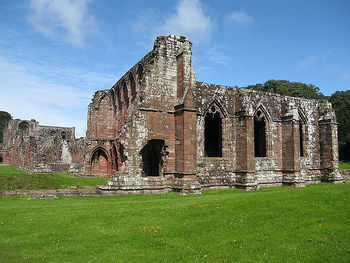Furness Abbey: Difference between revisions
imported>Richard Nevell (Starting article) |
imported>Richard Nevell (Add photo) |
||
| Line 1: | Line 1: | ||
{{subpages}} | {{subpages}} | ||
'''Furness Abbey''' was established in the early 12th century<ref>Wood, Jason (2011). “History of the Abbey” in ''Furness Abbey''. London: English Heritage. pp. 22–36. ISBN 978-1-85074-674-4.</ref> | {{Image|Furness Abbey, 2008.jpg|right|350px|The ruins of Furness Abbey in [[Cumbria]].}} | ||
'''Furness Abbey''' was established in the early 12th century.<ref>Wood, Jason (2011). “History of the Abbey” in ''Furness Abbey''. London: English Heritage. pp. 22–36. ISBN 978-1-85074-674-4.</ref> | |||
The community at Furness Abbey spawned several daughter monasteries. In 1134 the abbey of [[Calder Abbey|Calder]] and [[Rushen Abbey|Rushen]] were both founded by monks from Furness.<ref name=Wood25>Wood, “History of the Abbey”, p. 25.</ref> | The community at Furness Abbey spawned several daughter monasteries. In 1134 the abbey of [[Calder Abbey|Calder]] and [[Rushen Abbey|Rushen]] were both founded by monks from Furness.<ref name=Wood25>Wood, “History of the Abbey”, p. 25.</ref> | ||
Revision as of 13:12, 17 January 2013
Furness Abbey was established in the early 12th century.[1]
The community at Furness Abbey spawned several daughter monasteries. In 1134 the abbey of Calder and Rushen were both founded by monks from Furness.[2]
Furness was originally home to a community of Savigniac monks. Count Stephen of Boulogne invited them in 1124 to create a monastery in Lancashire. They first established themselves at Tulketh, but this was short lived and in 1127 they abandoned the site and moved to establish Furness Abbey. In 1147 the Savigniac order of monks was subsumed by the Cistercians. The abbot of Furness initially opposed the merger but eventually accepted it.[3] Further abbeys subservient to Furness were founded in 1180 (Inch in Ireland) and in 1205 (Abington).[2]
Amongst the properties held were the abbey were several castles including one which was actually built by the abbey on Piel Island.[4] The castle was first mentioned in 1327 when the abbey was granted a licence to crenellate their building on Piel Island. It is uncertain why the castle was built, though in the early 14th century northern England was subjected to Scottish raids and the fortification may have offered a degree of protection to the monastic community.[5]
Furness Abbey was dissolved in 1537, and afterwards the castle was recorded as in a poor state of repair and its condition gradually decayed over the following centuries.[6]
References
- ↑ Wood, Jason (2011). “History of the Abbey” in Furness Abbey. London: English Heritage. pp. 22–36. ISBN 978-1-85074-674-4.
- ↑ 2.0 2.1 Wood, “History of the Abbey”, p. 25.
- ↑ Wood, “History of the Abbey”, p. 23.
- ↑ Wood, “History of the Abbey”, p. 27
- ↑ Newman, Rachel (2011). “Piel Castle” in Furness Abbey. London: English Heritage. p. 37. ISBN 978-1-85074-674-4.
- ↑ Newman, “Piel Castle”, p. 38.
